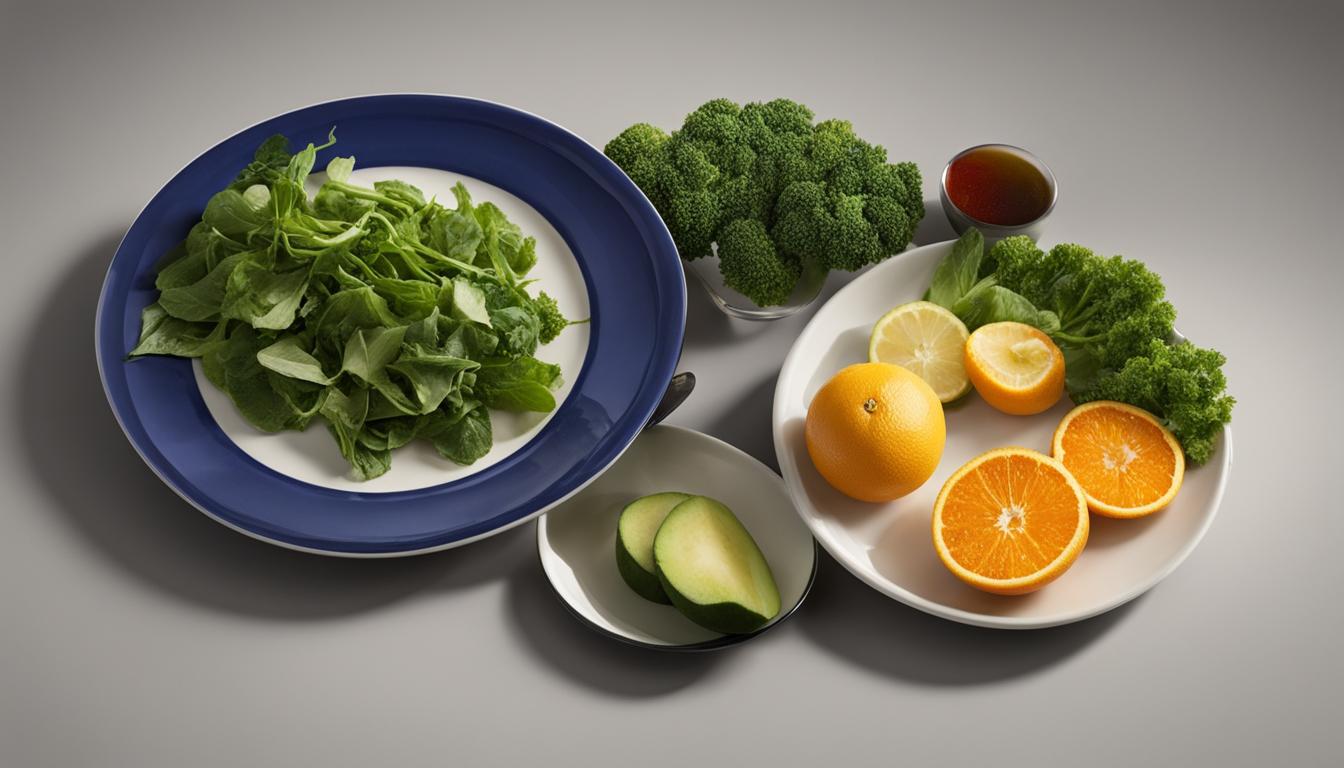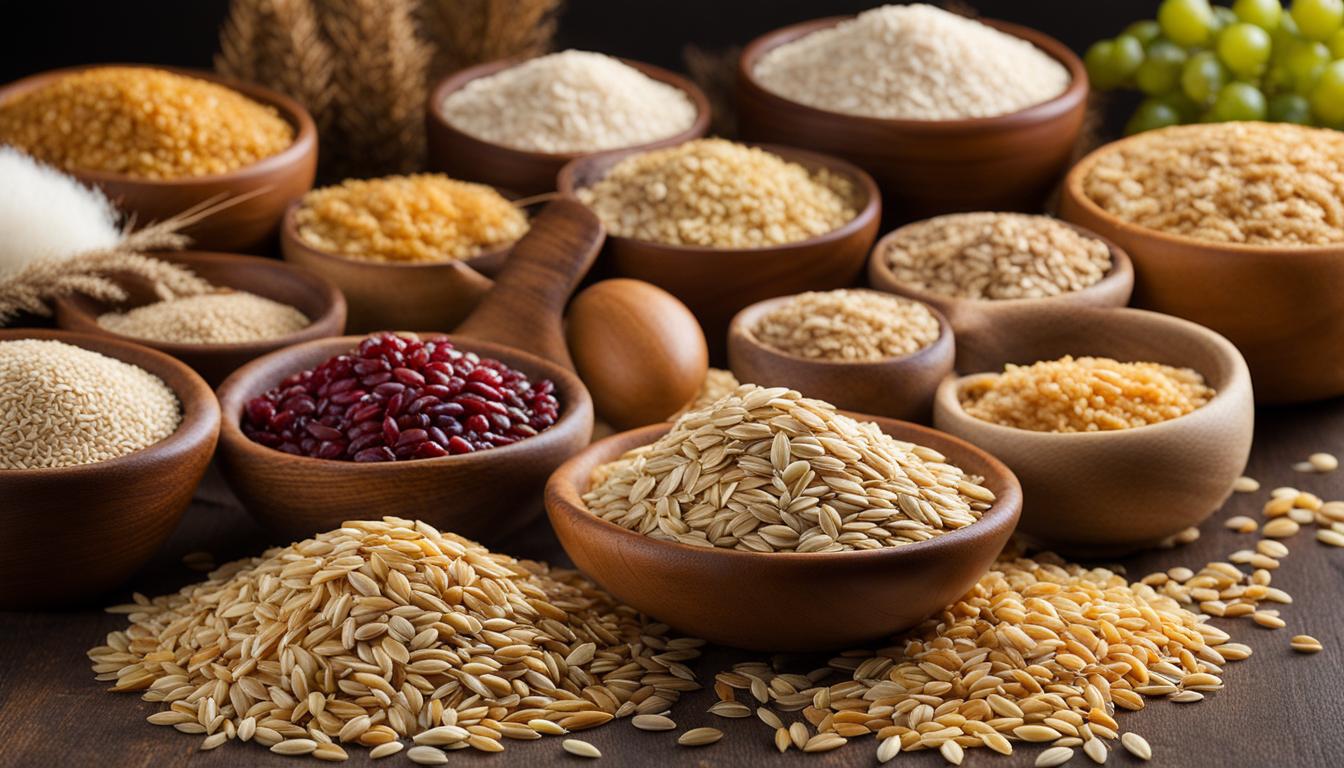Heart-healthy diets play a pivotal role in maintaining cardiovascular health and preventing heart disease. By making simple changes to our eating habits, we can significantly reduce the risk of heart-related conditions. In this article, we will dive into the best foods for a heart-healthy diet, including low cholesterol options, high fiber foods, and healthy fats. We will also explore heart-healthy recipes and lifestyle choices to promote overall cardiovascular well-being.
Key Takeaways:
- Heart-healthy diets are essential for maintaining cardiovascular health and preventing heart disease.
- Incorporating low cholesterol options, high fiber foods, and healthy fats into our meals can significantly reduce the risk of heart-related conditions.
- Heart-healthy recipes and lifestyle choices can contribute to overall cardiovascular well-being.
- Making small changes to our eating habits can lead to long-term benefits for heart health.
- By focusing on nutritious meals and adopting a heart-healthy lifestyle, we can prioritize our heart health and overall well-being.
Control Your Portion Size
Controlling your portion sizes is a key principle of a heart-healthy diet. Overeating can lead to consuming excessive calories, which can contribute to weight gain and increase the risk of heart disease. By using a small plate or bowl to control portions and focusing on low-calorie, nutrient-rich foods like fruits and vegetables, you can shape your diet to support a healthy heart. It’s also essential to be mindful of serving sizes and learn to judge them accurately to avoid overeating.
Portion control is about finding the right balance between enjoying the foods you love and ensuring you’re not consuming more than your body needs. By practicing portion control, you can still savor your favorite dishes while maintaining a heart-healthy lifestyle.
Remember, it’s not just about what you eat but how much you eat. By controlling your portion sizes, you can take control of your health and reduce the risk of heart disease.
One helpful tip for portion control is to use smaller plates and bowls. This simple trick visually creates the illusion of a fuller plate, allowing you to feel satisfied with smaller portions. Additionally, try using measuring cups or a food scale to accurately portion out your meals and snacks.

Incorporating low-calorie foods into your meals is another effective way to control portions. These foods are typically nutrient-dense and provide ample satisfaction without excessive calories. Filling your plate with colorful fruits and vegetables not only adds variety and visual appeal but also helps you feel fuller for longer.
High-calorie foods should be consumed in moderation. It’s important to be mindful of foods that are dense in calories but low in nutritional value, such as sugary snacks, fried foods, and processed treats. While it’s okay to indulge occasionally, incorporating them sparingly into your diet can help minimize their impact on your overall health.
The key is to find the right balance. A heart-healthy diet doesn’t have to be restrictive or boring. By controlling your portion sizes and focusing on nutrient-packed, low-calorie foods, you can enjoy a delicious and satisfying meal while nourishing your body and promoting heart health.
Increase Your Intake of Vegetables and Fruits
When it comes to maintaining a heart-healthy diet, fruits and vegetables are your best friends. These nutritional powerhouses are packed with essential vitamins, minerals, and dietary fiber, making them an excellent choice for cardiovascular health.
Incorporating more fruits and vegetables into your daily meals can have a significant impact on your overall well-being. Not only are they low in calories, but they also provide a plethora of health benefits. By replacing higher-calorie foods like meat, cheese, and snacks with a colorful array of fruits and vegetables, you can reduce the risk of heart disease.
One simple yet effective way to increase your intake of fruits and vegetables is to keep pre-cut options readily available for quick and easy snacking. Having sliced apples, carrot sticks, or cherry tomatoes on hand can be a great alternative to reaching for unhealthy snacks. Not only are they convenient, but they also satisfy your hunger and contribute to a heart-healthy diet.
Delicious and Heart-Healthy Recipes
Make your heart-healthy eating experience enjoyable and flavorful by trying out recipes that feature fruits and vegetables as the main ingredients. Whether it’s a refreshing salad with nutrient-rich greens, a colorful stir-fry with a variety of veggies, or a fruity smoothie bursting with antioxidants, there are countless ways to incorporate these plant-based foods into your meals.
For inspiration, check out this mouthwatering recipe:
“Grilled Vegetable Skewers with Tangy Yogurt Sauce”
– Serves 4
Ingredients:
- Assorted vegetables (bell peppers, zucchini, eggplant, cherry tomatoes, red onions)
- Olive oil
- Salt and pepper
- Plain Greek yogurt
- Fresh lemon juice
- Garlic powder
- Chopped fresh herbs (parsley, basil, or mint)
Instructions:
- Preheat grill to medium heat.
- Thread the vegetables onto skewers, alternating between different colors and textures.
- Brush the skewers with olive oil and season with salt and pepper.
- Place the skewers on the grill and cook for 10-15 minutes, turning occasionally until the vegetables are tender and lightly charred.
- In a small bowl, mix together the Greek yogurt, lemon juice, garlic powder, and chopped fresh herbs.
- Serve the grilled vegetable skewers with the tangy yogurt sauce on the side.
Enjoy the vibrant colors, delicious flavors, and heart-healthy benefits of this delightful recipe!
By increasing your intake of fruits and vegetables, you’re not just nourishing your body with essential nutrients, but also reducing the consumption of high-calorie foods that can contribute to heart disease risks. So embrace the beauty and abundance of fruits and vegetables and make them a central part of your heart-healthy diet.
Choose Whole Grains
When it comes to maintaining heart health, whole grains play a vital role. These grains are packed with dietary fiber and other essential nutrients that help regulate blood pressure and support overall cardiovascular well-being. Incorporating whole grains into your diet is as simple as making a few smart substitutions. For instance, opt for whole-grain bread or pasta instead of their refined counterparts. This small change can significantly increase the amount of whole grains in your meals, providing added nutritional value.
Don’t be afraid to explore new whole grains to add variety to your diet. Farro, quinoa, and barley are just a few examples of wholesome grains that can elevate your meals and boost heart health. By prioritizing whole grains in your diet and minimizing refined grain products like white bread or pasta, you can make a positive impact on your heart health.
Remember, every step towards incorporating more whole grains in your diet is a step towards a healthier heart. So, don’t hesitate to make simple yet impactful refined grain substitutions in your meals.

Why whole grains?
“Whole grains are an excellent source of dietary fiber, which helps regulate blood pressure and maintain a healthy heart.”
Limit Unhealthy Fats
In order to reduce blood cholesterol levels and lower the risk of coronary artery disease, it is crucial to limit the intake of unhealthy fats, such as saturated fats and trans fats. High levels of blood cholesterol can lead to the buildup of plaque in the arteries, increasing the chances of heart attack and stroke.
Choosing heart-healthy cooking oils is essential for maintaining good heart health. Opt for healthier fats, like monounsaturated fats found in olive oil or canola oil. These oils are beneficial for the heart and can help lower cholesterol levels. Cooking with these heart-healthy oils can be a great way to add flavor to your meals while taking care of your cardiovascular health.
Avoiding sources of trans fats is equally important. Trans fats, commonly found in partially hydrogenated or deep-fried foods, can be detrimental to heart health. These fats raise LDL cholesterol levels, also known as “bad” cholesterol, and lower HDL cholesterol levels, also known as “good” cholesterol. By avoiding trans fats, you can significantly reduce the risk of heart disease.
When cooking, it is recommended to use low-fat substitutions whenever possible. Choosing lean cuts of meat and trimming visible fat before cooking is a good practice. Additionally, be mindful of fat choices when preparing meals to limit saturated fats, which can also increase cholesterol levels and contribute to heart disease.

By making conscious choices to limit unhealthy fats and opting for heart-healthy cooking oils, you can take important steps towards maintaining a healthy heart and reducing the risk of cardiovascular diseases.
Choose Low-Fat Protein Sources
Selecting lean protein sources is essential for a heart-healthy diet. Incorporating lean meats, poultry, fish, and low-fat dairy products into your meals provides high-quality protein with lower fat content. For example, skinless chicken breasts are a nutritious choice that delivers lean protein without excessive fat. Fish, such as salmon or trout, is rich in omega-3 fatty acids, which can help lower blood triglyceride levels and support heart health.
For individuals following a vegetarian or plant-based diet, plant proteins can be excellent alternatives. Legumes like beans, peas, and lentils are low-fat protein sources that offer fiber and other essential nutrients. Substituting plant proteins for animal proteins can reduce fat and cholesterol intake while increasing your fiber intake, promoting heart health.
To add variety and flavor to your meals, experiment with heart-healthy substitutes. For example, choose low-fat dairy products, like skim milk or Greek yogurt, instead of their full-fat counterparts. These options provide the protein you need while minimizing saturated fat intake. Incorporating plant-based proteins, such as tofu or tempeh, into your favorite recipes can introduce new and exciting flavors to your heart-healthy diet.
It’s important to note that not all protein sources are equally heart-healthy. Processed meats, such as sausages or deli meats, often contain high levels of sodium and unhealthy fats. Be mindful of reading labels and choose fresh, unprocessed options whenever possible.

By choosing lean meats, poultry, fish, low-fat dairy products, and incorporating heart-healthy substitutes and plant-based proteins into your diet, you can enjoy a variety of delicious and nutritious meals that support your heart health.
Limit Sodium Intake
High sodium intake contributes to high blood pressure, a major risk factor for heart disease. To maintain a heart-healthy diet, it is crucial to limit salt and sodium intake. The American Heart Association recommends consuming no more than 2,300 milligrams (mg) of sodium per day for healthy adults.
One effective way to reduce sodium intake is by reducing the consumption of canned or processed foods, which often contain high amounts of sodium. These foods include canned soups, processed meats, and snack items. By opting for fresh, whole foods and preparing meals at home, you have better control over the amount of sodium in your diet.
To enhance the taste of your meals without adding excess sodium, try using herbs, spices, and other flavorings. They can provide delicious alternatives to salt and sodium-rich seasonings. Experimenting with different combinations of herbs and spices can add depth and flavor to your dishes while reducing sodium intake.
When shopping for condiments like ketchup or soy sauce, look for low-sodium versions. These alternatives can help reduce sodium intake, making them a healthier choice for your heart.
Reducing sodium intake is an essential step towards a heart-healthy lifestyle. By adopting these strategies and being mindful of the sodium content in your diet, you can take control of your heart health and reduce the risk of heart disease.

Expert Tip:
“Reducing sodium intake can be challenging, but small changes in your cooking and eating habits can make a big difference. Experiment with different herbs and spices to add flavor to your meals, and try making homemade versions of your favorite sauces and condiments to control the amount of sodium.” – Dr. Sarah Thompson, Cardiologist
Plan Ahead with Daily Menus
Meal planning is a crucial strategy for maintaining a heart-healthy diet. By taking the time to plan your daily menus, you can ensure that you are emphasizing the right foods to support your heart health. A heart-healthy menu should be focused on incorporating plenty of vegetables, fruits, whole grains, and lean proteins. These food groups provide essential nutrients and fiber that are beneficial for your heart.
When planning your meals, it is important to consider variety and balance. Including a variety of different foods ensures that you are getting a wide range of nutrients and flavors. This can help prevent meal monotony and make healthy eating more enjoyable. Additionally, a balanced diet accounts for appropriate portion sizes, ensuring that you are not overeating or undereating.
To create a heart-healthy menu, start by selecting your favorite recipes that incorporate the key food groups. Look for recipes that feature vegetables, fruits, whole grains, and lean proteins as the main components. Consider incorporating heart-healthy fats, such as those found in olive oil, nuts, and avocados.
Remember to pay attention to portion control as well. Measuring out appropriate portion sizes can help you maintain a balanced and heart-healthy diet. Using smaller plates and bowls can also assist in controlling portion sizes and avoiding overeating.
Incorporating the whole family in the meal planning process can be a fun and engaging way to create healthy eating habits together. Getting everyone involved in selecting recipes, grocery shopping, and preparing meals can foster a sense of ownership and make healthy eating a family affair.
Meal planning is not only beneficial for your heart health; it can also save you time, money, and energy. By having your meals planned and ingredients ready ahead of time, you can minimize last-minute meal decisions and reduce the temptation to opt for less healthy options.
By planning ahead with daily menus, you can ensure that your meals are heart-healthy and aligned with your dietary goals. This thoughtful approach to meal planning promotes variety, balance, and portion control, all of which are essential for maintaining a heart-healthy lifestyle.

Cooking at Home for Heart Health
Cooking at home is a practical approach to ensuring that your meals align with heart-healthy principles. By preparing your own meals, you have control over the ingredients and cooking methods, allowing for healthier choices and portion control. Unlike eating out or consuming processed foods, which often contain larger portion sizes and high amounts of sodium, sugar, and unhealthy fats, cooking at home gives you the ability to create nutritious and heart-friendly dishes.
One of the significant advantages of cooking at home is the knowledge you gain about the ingredients you use. By selecting fresh and wholesome ingredients, you can avoid the additives and preservatives commonly found in processed foods. This allows you to create meals that are free from unnecessary chemicals and are more aligned with a heart-healthy diet.
Moreover, cooking at home encourages culinary creativity. You can experiment with different flavors, cooking techniques, and combinations of ingredients to make your dishes more enjoyable. By exploring heart-healthy recipes, you can discover new ways to incorporate nutritious ingredients into your meals, further supporting your cardiovascular health.
When cooking at home, you can also take advantage of meal preparation strategies. By cooking in bulk and storing leftovers or freezing individual portions, you can save time and ensure that you always have convenient, healthy meal options available throughout the week. This is particularly helpful for individuals with busy schedules who may struggle to find the time to cook fresh meals every day.
By prioritizing home cooking, you can make positive changes to your lifestyle, contribute to a heart-healthy diet, and take control of your cardiovascular health.

Incorporating Heart-Healthy Recipes
When cooking at home, it’s essential to incorporate heart-healthy recipes that are both nutritious and delicious. By selecting recipes that include a variety of fruits, vegetables, whole grains, and lean proteins, you can maximize the nutritional value of your meals.
Try this flavorful recipe: Grilled Salmon with Quinoa and Roasted Vegetables. The omega-3 fatty acids in salmon promote heart health, while the quinoa and roasted vegetables provide fiber and essential nutrients. This dish is an excellent example of a heart-healthy recipe that is also satisfying and flavorful.
Experimenting with different herbs, spices, and seasonings can elevate the taste of your meals without relying on excessive salt or unhealthy fats. This way, you can create heart-healthy dishes that are full of flavor and enjoyable to eat.
Remember, cooking at home is not only about nourishing your body but also about fostering a connection with your food and ensuring that you make conscious choices for your heart health. So, grab your apron and get ready to savor the benefits of home-cooked meals!
Weight Control and Heart Health
Maintaining a healthy weight is crucial for heart health. When you carry excess weight, it puts a strain on your heart and increases the risk of high blood pressure and heart disease. Alongside following a heart-healthy diet, portion control plays a significant role in weight management.
Understanding serving sizes and aiming for appropriate portions can aid in weight loss or maintenance. It’s important to adopt a balanced approach to eating, being mindful of your energy intake. By focusing on portion control and incorporating a variety of nutrient-rich foods into your diet, you can support a healthy weight and reduce the risk of heart-related conditions.

Being mindful of your portion sizes and making conscious choices about what and how much you eat can help you achieve a healthy weight and maintain optimal heart health. By striving for a healthy weight through portion control and balanced eating, you can reduce the strain on your heart and lower the risk of heart disease.
Conclusion
Embracing a heart-healthy lifestyle is essential for maintaining cardiovascular health. By making simple changes to your eating habits and adopting healthy eating habits, you can significantly reduce the risk of heart disease and promote overall well-being. Prioritizing nutritious meals that are rich in fruits, vegetables, whole grains, lean proteins, and healthy fats can provide essential nutrients and support a healthy heart.
Limiting the intake of unhealthy fats, sodium, and practicing portion control are key components of a heart-healthy diet. Choosing low-sodium, low-fat options, and preparing meals at home allow for better control of ingredients and portion sizes. By planning your daily menus in advance and cooking at home, you can create a heart-healthy culinary experience that aligns with your dietary goals.
Remember, small changes in your dietary habits can make a big difference in your long-term heart health. By adopting a heart-healthy lifestyle and embracing nutritious meals and healthy eating habits, you are taking proactive steps towards reducing the risk of heart disease and promoting cardiovascular well-being.
FAQ
Why is a heart-healthy diet important?
A heart-healthy diet is important for preventing heart disease and maintaining cardiovascular health. It can significantly reduce the risk of heart disease and promote overall well-being.
How can portion control benefit heart health?
Controlling portion sizes helps prevent overeating and excessive calorie intake, which can contribute to weight gain and increase the risk of heart disease. Using smaller plates and focusing on low-calorie, nutrient-rich foods can support a healthy heart.
Why should I increase my intake of vegetables and fruits?
Vegetables and fruits are rich in vitamins, minerals, and dietary fiber, providing numerous health benefits. Incorporating more fruits and vegetables into your diet helps reduce the intake of higher-calorie foods and supports heart health.
Why should I choose whole grains?
Whole grains are an excellent source of dietary fiber and other nutrients that contribute to regulating blood pressure and maintaining heart health. Substituting refined grain products with whole grains can enhance the nutritional value of your meals.
Why should I limit unhealthy fats?
Limiting the intake of unhealthy fats, such as saturated and trans fats, helps reduce blood cholesterol levels and lower the risk of coronary artery disease. Choosing healthier fats, like monounsaturated fats found in oils, is beneficial for heart health.
What are good low-fat protein sources?
Skinless chicken breasts, fish, low-fat dairy products, and legumes like beans, peas, and lentils are excellent low-fat protein options. They provide high-quality protein without excessive fat and contribute to a heart-healthy diet.
How can I limit sodium intake?
Limiting salt/sodium intake is important for reducing high blood pressure, a major risk factor for heart disease. Avoiding canned or processed foods and using herbs, spices, and low-sodium condiments can help lower sodium intake.
How can I plan my daily menus for a heart-healthy diet?
Planning your daily menus with an emphasis on vegetables, fruits, whole grains, and lean proteins while limiting high-sodium and high-calorie foods is essential for heart health. Balancing your meals with appropriate portion sizes and incorporating a variety of nutrient-rich foods is key.
Why is cooking at home beneficial for heart health?
Cooking at home allows for healthier ingredient choices, portion control, and culinary creativity. Eating out or consuming processed foods often leads to larger portions and high amounts of sodium, unhealthy fats, and sugar. Cooking at home gives you control over the ingredients and cooking methods.
How does weight control affect heart health?
Maintaining a healthy weight is crucial for heart health. Excess weight puts a strain on the heart and increases the risk of high blood pressure and heart disease. Portion control and a balanced approach to eating support a healthy weight and reduce heart-related conditions.



